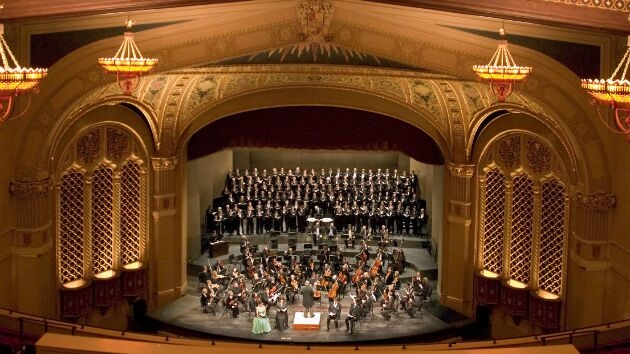
Carlos Vieu has been one of Symphony Silicon Valley’s most popular regular guest conductors for several years now. The Argentinian conductor’s appearance opening this year’s season at San José’s California Theatre last Friday demonstrated why. There were no guest soloists at this concert, just two large-scale and colorful tonal compositions, the conductor, and the orchestra that he leads so well.
One of the pieces is well-known, Tchaikovsky’s Symphony No. 6 in B Minor, the “Pathétique.” The other is less renowned, Zoltán Kodály’s Variations on a Hungarian Folksong (1939), known as the “Peacock Variations” from the title of the folksong.
The Peacock is not a particularly catchy song by Anglo-American standards, nor is Kodály out to drive the tune into listeners’ heads. It’s played in full in the introduction just once by the oboe (here Pamela Hakl, with simple pep), after a series of introductory fragments, and that’s immediately followed by the commencement of the variations. These are all colorful and thoroughly mutated, based more on the image of the song than on building elaborations around it.

The early variations are fast, lively, and brief, succeeding each other quickly and unobtrusively. About halfway through the piece the variations slow down and become lengthier, and the work ends with a long and more energetic finale.
Vieu had the orchestra play all the early variations in a bright and crisp manner with great intensity, giving them an energetic punch. Like Tchaikovsky, Kodály is a composer who likes to orchestrate in section blocks, putting different groups of instruments in dialogue or in simultaneous contrast. Vieu brings these contrasts and exchanges out vividly. This gives an energetic punch to the music, and by giving each successive variation a distinct character, separates each from the next.

Interestingly, though the Tchaikovsky doesn’t have a theme and variations, Vieu conducted the work the same way, dividing it into distinct sections and taking each on its own terms. When the tempo slows down in the first movement to introduce the lush second theme for strings, the sense of not just changing tempos, but switching to a different, more caressing mode of playing, was palpable.

Vieu treated the change the same way as the clarinet (Michael Corner at his most lyrical) and a brief tag from the bassoon bring the second theme to a close with utmost softness (Tchaikovsky marks the score with six p’s) and the entire orchestra slams into the development section with a loud and sudden tutti chord. Without evading the impact of the shift, Vieu calmly switched styles into one that just happened to be a lot louder.
He carried this sense of balance throughout the entire symphony. Performances of the “Pathétique” tend to face off between two different approaches. A conductor may emphasize the dark opening movement and the tragic finale, brushing aside the two more cheerful middle movements as incidental intermezzos. Or the emphasis can be on the middle, with the symphony seeming to end with the blazing conclusion of the peppy third-movement waltz, leaving the quiet finale dangling as an awkward appendage.
Vieu did neither. Treating the symphony as an assemblage of scenes, he took each movement simply as it came. There was no lack of blaze and excitement at the end of the third, which elicited a few cries of “wow” from the audience, but there was no applause at the end as a performance focused on that movement tends to elicit. Instead, Vieu turned to the Finale and pulled sound as rich, passionate, and intense out of the strings, which dominate this movement, as he had from the winds and brass earlier.
This was a thoughtful and sophisticated pair of performances which showed Symphony Silicon Valley responding with attentiveness and immediacy to its conductor’s conceptions.




